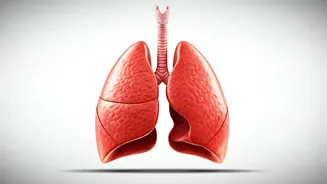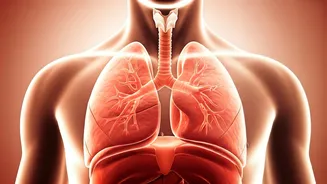Understanding Asthma Basics
Asthma is a chronic respiratory condition that affects millions. It's characterized by inflammation and narrowing of the airways, leading to difficulty
breathing, wheezing, coughing, and chest tightness. Asthma triggers vary from person to person and can include allergens (like pollen or dust mites), irritants (such as smoke or strong odors), infections, exercise, and even stress. The severity and frequency of asthma symptoms can fluctuate. Understanding the triggers, recognizing the symptoms, and knowing how to respond are essential steps in managing the condition. Effective asthma management often involves a combination of medical treatments, lifestyle adjustments, and learning techniques to help control breathing. Breathing exercises are a valuable part of this management strategy, working to improve lung function and reduce the frequency and intensity of asthma attacks. They can provide a sense of control and empowerment for those living with asthma, enabling them to lead more active and fulfilling lives.
Diaphragmatic Breathing Explained
Diaphragmatic breathing, also known as belly breathing, is a fundamental technique for asthma management. It focuses on using the diaphragm, a large muscle at the base of the lungs, to breathe deeply and efficiently. Unlike shallow chest breathing, diaphragmatic breathing encourages full lung expansion, allowing for greater oxygen intake. To practice this technique, one can start by sitting or lying down comfortably. Place one hand on the chest and the other on the abdomen. Breathe in slowly through the nose, feeling the abdomen rise as the diaphragm contracts and pushes downward. The chest should remain relatively still. Exhale slowly through the mouth, feeling the abdomen fall as the diaphragm relaxes. Repeat this process for several minutes, focusing on the rhythmic rise and fall of the abdomen. Regular practice of diaphragmatic breathing can help strengthen the diaphragm, improve lung capacity, and reduce the work of breathing, offering significant relief for those with asthma.
Pursed-Lip Breathing Technique
Pursed-lip breathing is another helpful technique to manage asthma symptoms, particularly during an asthma attack or when feeling short of breath. This method helps to slow down the breathing rate and keep the airways open longer, allowing for more efficient oxygen exchange. To practice pursed-lip breathing, start by relaxing the neck and shoulder muscles. Breathe in slowly through the nose, keeping the mouth closed. Then, purse the lips as if you're about to whistle. Exhale slowly and gently through the pursed lips, taking twice as long to exhale as you did to inhale. This controlled exhalation helps to create back pressure in the airways, preventing them from collapsing and trapping air. Practicing this technique can help clear out the trapped air, thereby making the next breath easier. Pursed-lip breathing can be employed at any time, especially during moments of breathlessness or stress, providing a readily accessible way to manage asthma symptoms effectively.
Breathing Exercises Benefits
Incorporating breathing exercises into a daily routine can offer a range of benefits for individuals with asthma. These exercises can help improve lung function by increasing the efficiency of breathing, leading to better oxygen levels in the body. They can also help reduce the frequency and severity of asthma symptoms by relaxing the airways and easing the work of breathing. Regular practice can decrease reliance on rescue inhalers and potentially reduce the need for hospital visits. Breathing exercises can also have a positive impact on the emotional well-being of people with asthma. They can help reduce stress and anxiety, which can worsen asthma symptoms. The controlled and mindful nature of these exercises promotes relaxation and a sense of control, contributing to a better quality of life. Consistent practice, coupled with medical management and avoiding triggers, can help individuals manage their asthma effectively.
Integrating Exercises Daily
Making breathing exercises a regular part of daily life requires consistency and mindful practice. Start by setting aside dedicated time each day, even just a few minutes, to practice the techniques. Find a quiet, comfortable space where you can relax without distractions. Begin with diaphragmatic breathing, focusing on slow, deep breaths, and then incorporate pursed-lip breathing if needed. Practice these exercises at different times of the day, such as in the morning, before bed, or during moments of stress. Remember to listen to your body and adapt the exercises to your needs; if you feel lightheaded, take a break and rest. It is crucial to use breathing exercises as a complement to, not a replacement for, any prescribed medication or medical advice. Breathing exercises are a valuable tool, used alongside medications and guidance from a healthcare provider, to effectively manage the symptoms and improve overall well-being. Regular practice can empower individuals with asthma to manage their condition more confidently.












